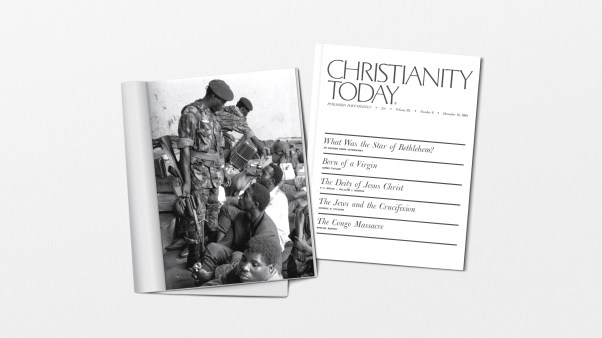Does giving up espresso bring me closer to God? This thought burned through my mind as I sat and listened to the boys’ choir sing Psalm 37 during Evensong at Christ Church Cathedral in Oxford, England, a few years ago. With Ash Wednesday a mere two days prior, it seemed like everyone was giving up lattes and social media and the internet and announcing it to the world. One friend defended fasting from these activities because of how they intrude on our daily lives. I agreed. I, too, could use a break from the digital world.
But what happens after Lent and Easter Sunday, I thought to myself. Business as usual? Fire up the espresso machines? Tweet that I’m back from my social media fast?
Though I respected the beauty and depth represented in the tradition of Lent, tension grew in me. I struggled to align the good and holy intent of Lenten fasts with the very public spectacle it has evolved into for Western Christianity. We announce our screen time fasts or “disfigure our faces” when asked why we won’t have a glass of wine. Jesus exhorts his disciples to keep fasting a secret matter—an unseen act of worship to the God who is unseen (Matt. 6:16–18).
I loved how the season leading up to Resurrection Sunday swelled into what J. R. R. Tolkien called the eucatastrophe or the joyous upturn in the story of the human race. But I also observed how the pageantry fades. I loved the idea of abstaining from vices and stepping into Christ’s suffering. But I thought the spiritual discipline of fasting was meant to be more than a seasonal practice to abstain from first-world luxuries.
It was then I began a personal quest to seek out the heart of Lent.
Seeking the Heart of Lent
Historically, some of the first indications of a seasonal fast appear to be even earlier than the Council of Nicea (c. A.D. 325) in practices like fasting before baptism and Easter, which only lasted a few days. But some church scholars now believe that the Lenten 40-day fast dates to a later time in the history of the church. Nicholas Russo, advising dean at the College of Arts and Humanities at the University of Notre Dame, suggests the fixed 40-day fast emerged after the Council of Nicaea, and that the early history of Lent is something of a “choose your own adventure,” and an “amalgamation of several early fasting customs and typologies.”
We may not know the direct origins of the present-day Lenten fast, but we do know the significance of the discipline. The Lenten 40-day fast pays homage to the iconic fasts found in Scripture—from Moses on Mount Sinai (Ex. 34:28) to Jesus’ wilderness fast (Luke 4:1–13). The Scriptures brim with other examples of fasting: Elijah, Ezra, Nehemiah, David, Esther, John the Baptist, and Paul, among many others.
We’re not wrong to follow suit. St. Augustine exhorted Christians to overcome “the temptations of this age, the crafty traps of the devil, the toils of the world, the allurements of the flesh, the swirl of turbulent times, and all bodily and spiritual adversity,” with fasting. We should use the nails of abstinence to hammer our lusts to the cross, he says.
But at the same time, he warned Christians not to make fasting a pretense by using Lent as a time to simply revise their pleasures, substituting one vice for a different one. “You must certainly beware of just revising, not reducing, your pleasures,” wrote Augustine in Sermon 207. “You can see some people searching out unusual liquors as a substitute for the usual wine. … The result is that the observance of Lent means, not the repression of old lusts, but the occasion for new enjoyments.”
We fast, according to Augustine, so that inordinate affections do not control us. When we fast, “the delights of the flesh are to be held in check. Esau wasn’t rejected over Weiner schnitzel or pâté de foie gras but an inordinate longing for lentils.”
Rowan Williams, master of Magdalene College at the University of Cambridge, said, “The self-denial involved in the period of Lent isn’t about just giving up chocolates or beer; it’s about trying to give up a certain set of pictures of God which are burned into our own selfish wants.”
Williams reminds us of the Pevensie children in C. S. Lewis’s The Lion, The Witch, and The Wardrobe when they first heard Mr. Beaver mention that Aslan was a lion. The children could not conceive of a lion that was both wild and good. Aslan represents something wholly other to the children. Our self-made notions of God quite often need to be (re)awakened to the God that is. We want a God who is safe, one made in our image. A self-centered approach to fasting echoes this sentiment.
The Israelites discovered this the hard way. In Isaiah 58, the premier biblical text for fasting, we find the Israelites confused. They fasted in hopes that God would draw near to them. But their empty religious expressions nauseated God. They fasted but treated others poorly. Their actions did not match their hearts.
“We humbled ourselves,” they complained. But God does not desire a show of humility. I’m reminded of Pascal’s words: “It is better not to fast, and be thereby humbled, than to fast and be self-satisfied therewith.” God desires a fasting in which we turn our hearts toward him and seek to love our neighbor.
In his book Fasting, Scot McKnight warns that evangelical Christianity can often treat fasting as something we do to get a result—like the Israelites in Isaiah 58. Need wisdom for a big decision? Fast. Need to reach your financial goal for that new youth wing? Fast. Need to break the cycle of checking your Instagram feed? Fast.
The Scriptures, however, show fasting used as both a pathway for spiritual breakthroughs (Joel 2:12) and as a response to a grievous sacred moment (2 Sam. 12:16–23). The central focus of fasting remains to draw near to God. It reveals sins from which we must repent. Fasting is an act of worship that changes our spiritual and physical posture toward God.
A Forgotten Discipline?
As a demanding form of worship, fasting causes dissonance in a culture of abundance. When Richard Foster first published his modern classic Celebration of Discipline in 1978, he noted that when he researched fasting, not one book on the discipline had been written in more than 100 years. Why? Foster suggests two reasons.
First, Christian culture reacted to the “excessive ascetic practices of the Middle Ages.” Second, our culture encourages the satisfaction of “every human appetite.” Foster is not alone in his observation of the Christian neglect of fasting.
On June 7, 1763, John Wesley wrote in his journal: “Is not the neglect of this plain duty (I mean fasting, ranked by our Lord with almsgiving and prayer) one general occasion of deadness among Christians? Can anyone willingly neglect it and be guiltless?” Going back further, Thomas A Kempis observed how Jesus “finds many to share his table, but few to take part in his fasting.”
More recently, in his book Eat, Fast, Feast, writer and scholar Jay W. Richards ascribes the near vanishing of fasting in the church to Christian divisions. From the East and West schism of 1054 to the Protestant Reformation in 1517, fasting gradually diminished to a vestigial practice, and calendar fasts like Lent devolved into selective abstention rather than true fasting. Richards laments, “It’s hard not to notice that a decline in fasting has tracked closely with a decline in holiness and faithfulness to perennial Christian teaching.
Proponents of the Lenten fast argue that it contributes to the act of refocusing our gaze upon God as we prepare for Easter. You can fast the rest of the year whenever you want—in theory. In reality, when it comes to fasting, Barna found in a 2004 study that people who adhere to a non-Christian faith are more likely to fast than Christians.
The same defenders of Lenten fasting admit that the very public and trendy participation in Lent has gotten out of hand, but they argue that doesn’t make observing the season wrong. However, it can and does reveal the substance of our devotion. If Lent becomes a substitute for a lifestyle of pursuing the spiritual discipline of biblical fasting, or if it loses the heart of devotion and simply becomes a trendy ritual, is it not worthless?
The ministerial traditions and accumulated wisdom of the church serves and guides us in our spiritual formation. But if a tradition of the church, such as Lent, takes on the veneer of our culture, then it’s time to revive the heart of the practice.
A Lenten Lifestyle
That day at Christ Church, as the rector prayed for a blessed “reordering during these Lenten days,” I wondered what my Christian life might look like if the spirit of Lent filled my days year-round, and not just the 40 days before Easter. Years later, the thought returned with new conviction.
On a holiday trip to visit relatives in Lititz, Pennsylvania, I grabbed my unread copy of Søren Kierkegaard’s Philosophical Fragments. The Danish philosopher seized my attention in a passage in which he observed the lowly lifestyle of Jesus. Jesus did not bring attention to himself, he said, and did not attempt to lure the masses. He lived humbly as a servant. He did not benefit from earthly possessions, nor do we get the sense from Scripture that Jesus desired possessions during his ministry.
“He did not trouble himself with house or home,” writes Kierkegaard. Jesus did not seek the romantic company of a woman, nor was he drawn to things that “usually claim the attention of men.” So far, I was tracking. But then Kierkegaard asked something that surprised me: Is it appropriate for us to follow Christ’s example of going without?
“The question,” says Kierkegaard, “is whether a human being may venture to express the same idea.” Meaning, should we seek to be physical and spiritual minimalists as the Christ apparently was, utterly reliant upon his Father in heaven? Kierkegaard answers this question with a resounding y es.
But there was a condition to his answer. A man or woman may so venture, he wrote, if he or she possesses the needed strength to:
lose himself in the service of the spirit that it never occurs to him to take care for meat and drink; if he is certain that want will not distract him, and that distress will not confound for him the structure of his life and teach him to rue that he did not first master the simple things before he presumed to understand more—then he may indeed venture, and his greatness will be more glorious than the serene security of the lilies of the field.
With our needs and wants literally at our fingertips, we deny ourselves nothing in this world. I am chief among the “Buy Now With 1-Click” crowd. We become accustomed to ease and nonchalance and convince ourselves we cannot go without.
The thread of simplicity in Kierkegaard’s sketch of Jesus challenged me to assess my own spiritual and physical flab. Had I become a glutton of the luxuries we so easily take for granted? I began cutting the fat: editing my closet, chucking junk in the garage, slapping a governor on my consumption, and embarking on an odyssey of regular fasting. Simplicity, as my friend Larry reminds me, serves as a precursor to fasting.
Kierkegaard’s most beautiful and passionate discourses ring with the idea of simplifying—of getting out from the crowd and being a solitary figure before the Lord. Here, joy abounds, like it does for the lilies and the birds; “a joy of silence and obedience.” In Purity of Heart, Kierkegaard sounds the bell for simplifying the distractions of life in order to get down to the spiritual business of confession. “To strip oneself,” writes Kierkegaard, “of all that is as full of noise as it is empty, in order to be hidden in the silence. … This silence is the simple festivity of the holy act of confession.”
I found in Lent an invitation to shed a bit of my selfish self for a time and to reorder my spiritual perspectives, as Williams suggests. But I also discovered a more costly yet spiritually beautiful life waiting beyond the seasonal fast.
Rather than a season, what if we practiced a daily lifestyle of Lenten reordering of fullness and joy as we look back on our marred selves and glory in its newness? What if we heeded St. Basil, who urges us to abandon “fasting done for publicity” and to “run to greet the cheerful act of the fast” as a gift from God?
That day, as I left Christ Church, the spirit of Lent whispered to me of reordering. How might I better align my daily cadence to God’s? How saturated are my purposes and desires in his? How obedient am I to his calling on my life? Does my fasting matter if I am not living obediently? Does my fasting matter if I live insistent upon satisfying my own cravings?
In Psalm 37, David shows us what a heart pursuant of God looks like. Trust in the Lord, take delight in the Lord, commit your way to the Lord, be still before the Lord, wait patiently, hope in the Lord, keep his way, take refuge in him. Trust, commit, delight, wait, silence; these are words of “giving up” of “going without” whatever the world offers and resting in God. But I must discipline myself in going without and resting in.
In fasting, a person must fight through the appetite to remain focused on the act of pursuing God and loving others. If a person can push through these hunger pains, they discover that they’re just fine on the other side of them. Pushing past that threshold of desire requires discipline and trust. It requires a person committed to “eating God” at that moment and relying on only him as sustenance. Fasting requires me to look to God continually. To talk to him. To open myself up to him in confession.
I’m not giving up anything for Lent this year. Instead, I am committing anew to hearing the voice of God in my life through regular fasting, and, by God’s grace, practicing the dance of the lilies and the song of the birds in the hidden theater of the unseen God.
Timothy Willard (PhD, King’s College London) is a writer, podcaster, and independent scholar based in Charlotte, North Carolina, where he lives with his wife, three daughters, and a band of rowdy Great Horned Owls. He is the author of three books and the rider of mountain trails.









